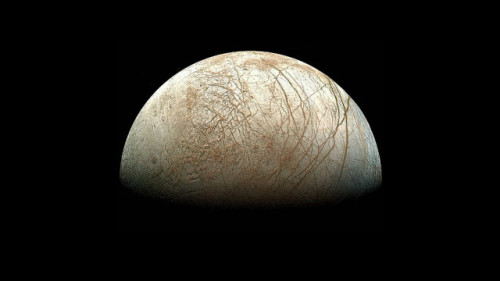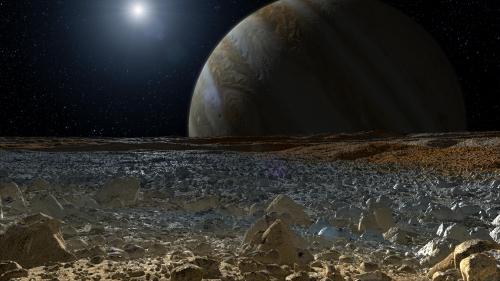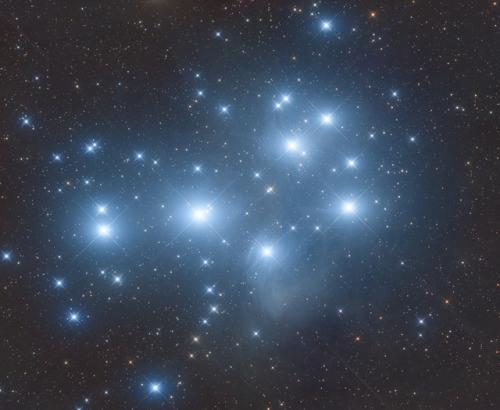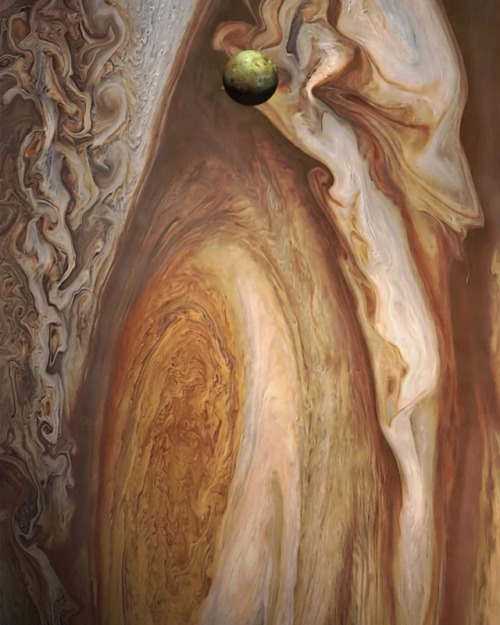Tres-4b-blog - ✰

More Posts from Tres-4b-blog and Others
List of extrasolar candidates for liquid water
The following list contains candidates from the list of confirmed objects that meet the following criteria:
Confirmed object orbiting within a circumstellar habitable zone of Earth mass or greater (because smaller objects may not have the gravitational means to retain water) but not a star
Has been studied for more than a year
Confirmed surface with strong evidence for it being either solid or liquid
Water vapour detected in its atmosphere
Gravitational, radio or differentation models that predict a wet stratum
55 Cancri f

With a mass half that of Saturn, 55 Cancri f is likely to be a gas giant with no solid surface. It orbits in the so-called “habitable zone,” which means that liquid water could exist on the surface of a possible moon. ]
Proxima Centauri b

Proxima Centauri b is an exoplanet orbiting in the habitable zone of the red dwarfstar Proxima Centauri, which is the closest star to the Sun and part of a triple star system. It is located about 4.2 light-years from Earth in the constellation of Centaurus, making it the closest known exoplanet to the Solar System.
Gliese 581c

Gliese 581c gained interest from astronomers because it was reported to be the first potentially Earth-like planet in the habitable zone of its star, with a temperature right for liquid water on its surface, and by extension, potentially capable of supporting extremophile forms of Earth-like life.
Gliese 667 Cc

Gliese 667 Cc is an exoplanet orbiting within the habitable zone of the red dwarf star Gliese 667 C, which is a member of the Gliese 667 triple star system, approximately 23.62 light-years away in the constellation of Scorpius.
Gliese 1214 b

Gliese 1214 b is an exoplanet that orbits the star Gliese 1214, and was discovered in December 2009. Its parent star is 48 light-years from the Sun, in the constellation Ophiuchus. As of 2017, GJ 1214 b is the most likely known candidate for being an ocean planet. For that reason, scientists have nicknamed the planet “the waterworld”.
HD 85512 b

HD 85512 b is an exoplanet orbiting HD 85512, a K-type main-sequence star approximately 36 light-years from Earth in the constellation of Vela.
Due to its mass of at least 3.6 times the mass of Earth, HD 85512 b is classified as a rocky Earth-size exoplanet (<5M⊕) and is one of the smallest exoplanets discovered to be just outside the inner edge of the habitable zone.
MOA-2007-BLG-192Lb

MOA-2007-BLG-192Lb, occasionally shortened to MOA-192 b, is an extrasolar planet approximately 3,000 light-years away in the constellation of Sagittarius. The planet was discovered orbiting the brown dwarf or low-mass star MOA-2007-BLG-192L. At a mass of approximately 3.3 times Earth, it is one of the lowest-mass extrasolar planets at the time of discovery. It was found when it caused a gravitational microlensing event on May 24, 2007, which was detected as part of the MOA-II microlensing survey at the Mount John University Observatory in New Zealand.
Kepler-22b

Kepler-22b, also known by its Kepler object of interest designation KOI-087.01, is an extrasolar planet orbiting within the habitable zone of the Sun-like star Kepler-22. It is located about 587 light-years (180 pc) from Earth in the constellation of Cygnus. source


NASA plans a robotic mission to search for life on Europa | io9
It looks like it’s finally going to happen, an actual mission to Jupiter’s icy moon Europa — one of the the solar system’s best candidates for hosting alien life.
Yesterday, NASA announced an injection of $17.5 billion from the federal government (down by $1.2 billion from its 2010 peak). Of this, $15 million will be allocated for “pre-formulation” work on a mission to Europa, with plans to make detailed observations from orbit and possibly sample its interior oceans with a robotic probe. Mission details are sparse, but if all goes well, it could be launched by 2025 and arriving in the early 2030s.
This is incredibly exciting. Recent evidence points to a reasonable chance of habitability. Its massive subsurface ocean contains almost twice as much water as found on Earth. The water is kept in liquid state owing to the gravitational forces exerted by Jupiter and the moon’s turbulent global ocean currents. The good news is that a probe may not have to dig very deep to conduct its search for life; the moon’s massive plumes are ejecting water directly onto the surface.
[Read more]

Astronaut Scott Kelly Playing Ping-Pong in Space with Water and Hydrophobic Paddles.
Via NASA Johnson

We know more about the surfaces of Mars and the moon than we do about the bottom of our oceans. Source Source 2 Source 3
-
 movedmovedmovedmovedmovedlo-blog liked this · 5 years ago
movedmovedmovedmovedmovedlo-blog liked this · 5 years ago -
 keinhalloweenfuernzs liked this · 5 years ago
keinhalloweenfuernzs liked this · 5 years ago -
 gloriouscloudwolfnickel-blog liked this · 5 years ago
gloriouscloudwolfnickel-blog liked this · 5 years ago -
 glitterxbug liked this · 5 years ago
glitterxbug liked this · 5 years ago -
 elonmusksfanboy-blog liked this · 5 years ago
elonmusksfanboy-blog liked this · 5 years ago -
 lescalierdelesprit liked this · 5 years ago
lescalierdelesprit liked this · 5 years ago -
 ehca-hcamots liked this · 5 years ago
ehca-hcamots liked this · 5 years ago -
 tres-4b-blog reblogged this · 6 years ago
tres-4b-blog reblogged this · 6 years ago -
 piyi3alalimmi liked this · 6 years ago
piyi3alalimmi liked this · 6 years ago -
 helpimlostinthetardis liked this · 6 years ago
helpimlostinthetardis liked this · 6 years ago -
 sigourneyweaver69 liked this · 6 years ago
sigourneyweaver69 liked this · 6 years ago -
 the-art-of-evil-thoughts liked this · 6 years ago
the-art-of-evil-thoughts liked this · 6 years ago -
 335am liked this · 6 years ago
335am liked this · 6 years ago -
 andanotherfan reblogged this · 6 years ago
andanotherfan reblogged this · 6 years ago -
 scary-ivy liked this · 6 years ago
scary-ivy liked this · 6 years ago -
 sprintin-tarantino liked this · 6 years ago
sprintin-tarantino liked this · 6 years ago -
 freakwit-blog liked this · 6 years ago
freakwit-blog liked this · 6 years ago -
 thedownfaller liked this · 6 years ago
thedownfaller liked this · 6 years ago -
 multi-x-fffandom33x-blog liked this · 6 years ago
multi-x-fffandom33x-blog liked this · 6 years ago -
 castrolle liked this · 6 years ago
castrolle liked this · 6 years ago -
 dulzuraenverano liked this · 6 years ago
dulzuraenverano liked this · 6 years ago -
 nuboa-blog reblogged this · 6 years ago
nuboa-blog reblogged this · 6 years ago -
 morons-never-change liked this · 6 years ago
morons-never-change liked this · 6 years ago -
 klovesmia reblogged this · 6 years ago
klovesmia reblogged this · 6 years ago -
 spookymulderjr reblogged this · 6 years ago
spookymulderjr reblogged this · 6 years ago -
 spookymulderjr liked this · 6 years ago
spookymulderjr liked this · 6 years ago -
 suyigri79 reblogged this · 6 years ago
suyigri79 reblogged this · 6 years ago -
 suyigri79 liked this · 6 years ago
suyigri79 liked this · 6 years ago -
 richard-from-the-orchard liked this · 6 years ago
richard-from-the-orchard liked this · 6 years ago -
 megadextrious liked this · 6 years ago
megadextrious liked this · 6 years ago -
 friskrosx liked this · 6 years ago
friskrosx liked this · 6 years ago -
 rich-witch reblogged this · 6 years ago
rich-witch reblogged this · 6 years ago -
 fuccme reblogged this · 6 years ago
fuccme reblogged this · 6 years ago -
 valianttreesheep liked this · 6 years ago
valianttreesheep liked this · 6 years ago -
 platypusparfait liked this · 6 years ago
platypusparfait liked this · 6 years ago -
 thestumpyone liked this · 6 years ago
thestumpyone liked this · 6 years ago -
 puertoricanmage liked this · 6 years ago
puertoricanmage liked this · 6 years ago -
 babybardot94 reblogged this · 6 years ago
babybardot94 reblogged this · 6 years ago -
 gonzogender liked this · 6 years ago
gonzogender liked this · 6 years ago -
 snailruler liked this · 6 years ago
snailruler liked this · 6 years ago -
 envyhunter reblogged this · 6 years ago
envyhunter reblogged this · 6 years ago -
 envyhunter liked this · 6 years ago
envyhunter liked this · 6 years ago -
 yubsabi liked this · 6 years ago
yubsabi liked this · 6 years ago -
 chainsawpanda reblogged this · 6 years ago
chainsawpanda reblogged this · 6 years ago




